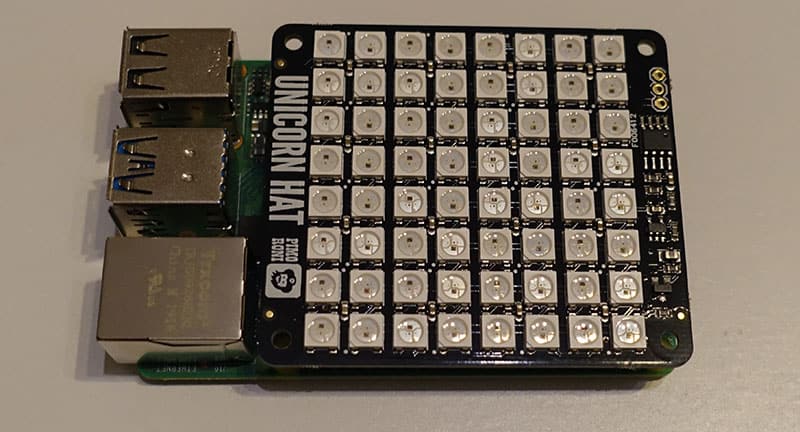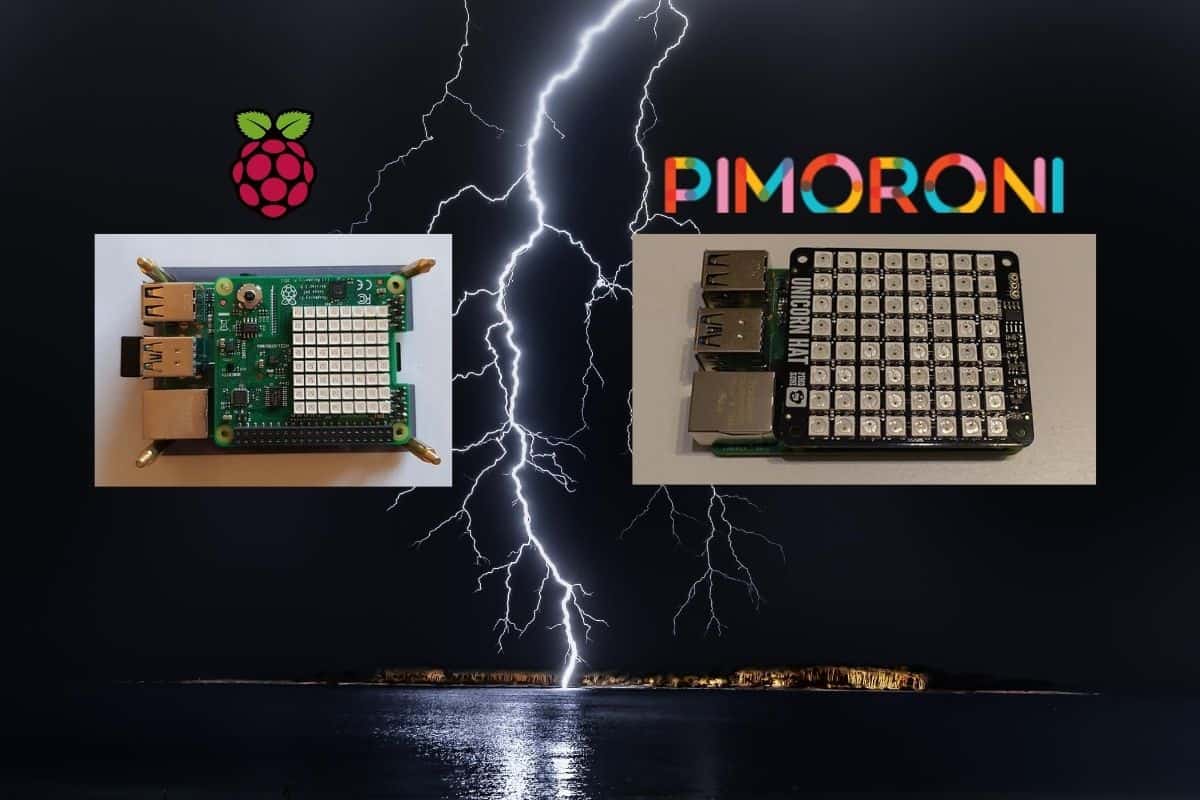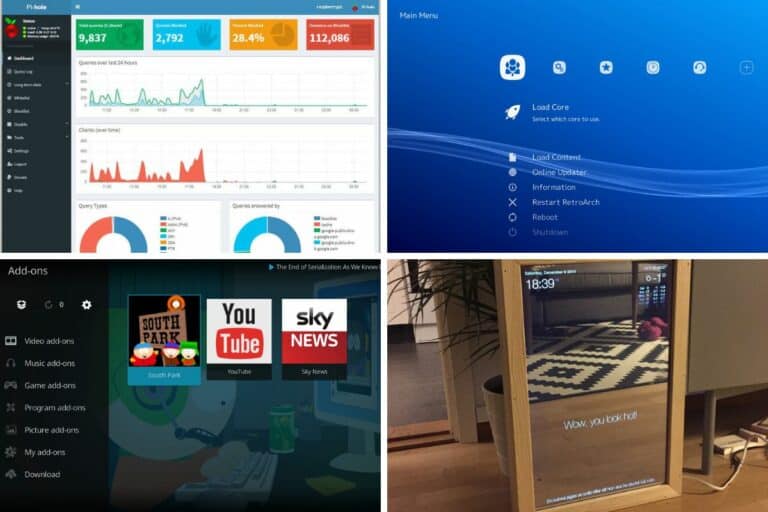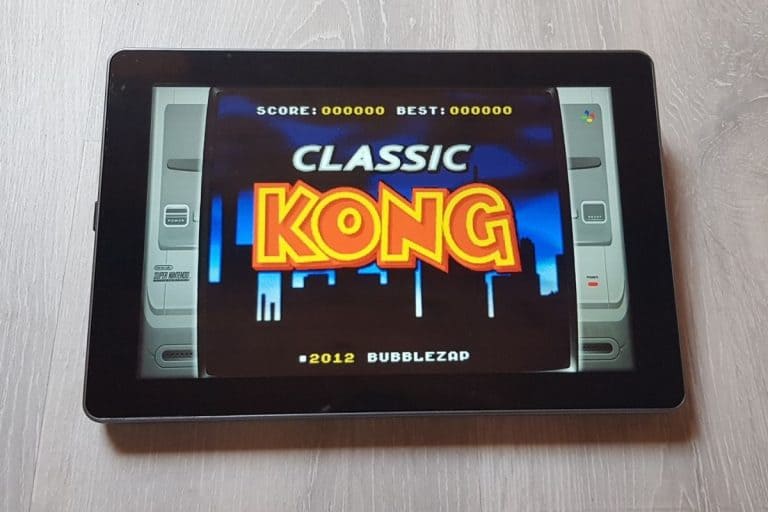Raspberry Pi: Sense HAT vs Unicorn HAT, which one to choose?
The Sense HAT is the most popular extension on the Raspberry Pi. Created by the Raspberry Pi Foundation, it offers many features. But is there a better choice available, like the Pimoroni Unicorn HAT?
Sense HAT and Unicorn HAT include a similar 8×8 LED matrix on the top.
The one from Pimoroni is bigger, but the sense HAT offers several other features like temperature, humidity and more.
Let’s see in this post the complete differences between both, and which one to choose in your case.
Note: as a reminder, “HAT” means “Hardware Attached on Top”. It’s a standard for Raspberry Pi extensions boards. They are almost plug & play, with the GPIO pins.
By the way, if you get overwhelmed as soon as Python is required for a project, I recommend checking out my e-book “Master Python on Raspberry Pi“. It will guide you step-by-step to learn the essential concepts (and only the essential concepts) required to achieve any project in the future. Raspberry Pi without Python is like a car without an engine, you miss all the fun parts. Get 10% off by downloading it today!
Raspberry Pi Sense HAT
Let’s start with the Sense HAT, an official extension from the Raspberry Pi Foundation.
Story
Firstly branded as “Astro Pi”, the Sense HAT has an interesting story.
Astro Pi is the name of a small computer, created by the Raspberry Pi Foundation for the International Space Station.
Basically, it’s a Raspberry Pi and a Sense HAT in a specific case for the astronauts.

With so many features (I will detail this in the next paragraph), the Astro Pi is the perfect tool to lead some experiment in space.
A competition also took place for students to run their experiments (from Earth obviously).
If you are interested and want more information, check the Astro-Pi website here.
If you are lost in all these new words and abbreviations, request my free Raspberry Pi glossary here (PDF format)!
Download now
Features
As you can see on this picture, the main feature we note on the Sense HAT is the 8×8 LED Matrix. But there are many other ones included to create all sorts of experiments.

Here is a complete list:
- 8×8 RGB LED Matrix
- A joystick
- Humidity sensor
- Gyroscope (rotation)
- Temperature sensor
- Barometer (air pressure)
- Accelerometer (movement)
So it’s really a good extension for beginners, as you can invest in one card to run multiple experiments, without spending too much money on them.
How to use it?
The Sense HAT is intended to work with a Python library. It’s already installed on Raspberry Pi OS Full, but you might need to install it depending on your system version.
Join Our Community!
Connect, learn, and grow with other Raspberry Pi enthusiasts. Support RaspberryTips and enjoy an ad-free reading experience. Get exclusive monthly video tutorials and many other benefits.
Learn moreI have an entire tutorial on how to get started with the Raspberry Pi Sense HAT, I recommend you checking it if needed.
Pricing
The Raspberry Pi Sense Hat is pretty affordable, given the features offered (check the current price on Amazon).
If you want to start using your GPIO Pins, or even if you already know how to do this but want to have more choices for your project, it’s a good investment.
As it’s built by the Raspberry Pi Foundation, you can easily find help on their website, and also on many websites and forums. You’ll not be lost, even if it’s your first HAT (and my tutorial should help a lot to get started).
Pimoroni Unicorn HAT
Presentation
Pimoroni is an electronics company, mainly known for their Raspberry Pi extensions. They are also based in the UK.
They have a solid reputation in this field, and create excellent products.
The Unicorn HAT look is very similar to the Sense HAT:

Features
There is a giant RGB LED Matrix on the top. It’s also 8×8 but the LED are bigger and takes up all the space.
As for any HAT, you can plug directly the extension on the GPIO ports, and a Python library is provided to manage the LED matrix.
But, it’s the only feature you’ll get with it. So, it’s a good choice if your goal is to have a big LED screen, but don’t expect anything else.
If you are lost in all these new words and abbreviations, request my free Raspberry Pi glossary here (PDF format)!
Download now
How to use it?
I bought mine for this article, to see how it works, so I’m not yet experimented with it. But Pimoroni also has a dedicated Python library to help you to use it (GitHub link).
They are many examples you’ll get with the library. So, you can try many things without doing any code. And once you are ready to try your code, you can take the examples as a basis.
I will probably write a detailed tutorial in the next few months if you are interested, but for now, you can check the one from Pimoroni on their official website.
If you are not sure with Python, you can always check my beginner tutorial about this language here.
Pricing
The Pimoroni Unicorn HAT is available at a decent price (check on Amazon).
It’s an easy-to-use HAT to get started. You can start from the examples and build your project with it.
It’s far to be the cheapest HAT available, but it’s a good solution to play with a LED Matrix.
For your information, an HD HAT is also available (with 256 RGB LEDs but double the price) and a pHAT (for Raspberry Pi Zero).
It's a free PDF guide containing every Raspberry Pi Linux command you should know!
Download now
Differences between Sense HAT and Unicorn HAT
Features
As listed before, the Sense HAT includes much more feature like temperature, humidity, air pressure, etc.
Whereas the Unicorn HAT is only a bigger LED Matrix, without other features.
So depending on your goal, you can probably already make a choice between both (I will help you later if needed).
Usage / projects
The Unicorn HAT allows you to build very cool cases to play with the light from the LED matrix (this one is 3D printed and acts as an audio visualizer).
On Sense HAT, the visual will probably not be as good, but the main strength of the Sense HAT is that it includes several features.
Except if you have a specific project to build with lights, the Sense HAT will keep you busy longer than the Unicorn HAT.
Pricing
As explained in the previous sections, both HAT are available at a decent price.
In fact, it’s even the same price for both.
So, your choice will probably not depend on the price, but on the features you need.
The Raspberry Pi Sense HAT has more interesting features, but the Pimoroni Unicorn HAT is focus on the LED Matrix.
It really depends on how you want to use it.
Recommendation
If I can try a recommendation knowing this, I would advise starting with the Sense Hat (direct link to Amazon).
This way, you can experiment several things (LED Matrix but also Temperature, Accelerometer, etc.), and create more projects with it.
It’s also a perfect tool to learn Python from scratch. You can follow an example for the first feature. Then just read the documentation and try another thing with the next feature, etc.
Once you know how to use them all, you would have pretty solid knowledge in Python.
The main problem that users often report with the Sense HAT is that is perfect for beginners, but as soon as you want to go further, you’ll be stuck by poor sensors and not enough freedom.
So, if you are an experimented user, maybe the best idea is to find a pack like this one on Amazon, with dozens of sensors that you can use in your circuits.
The Unicorn HAT is not a bad device I think, but it’s only useful for light projects, so very limited for me (and the price is the same…).
It's a free PDF guide containing every Raspberry Pi Linux command you should know!
Download now
Reminder: Remember that all the members of my community get access to this website without ads, exclusive courses and much more. You can become part of this community for as little as $5 per month & get all the benefits immediately.
Conclusion
That’s it for this quick comparison between the Sense HAT and the Unicorn HAT. I hope it was useful for you, with a good overview of both products.
As I wrote earlier in this chapter, I will try to build a few projects with the Unicorn HAT that I know less, and probably give you a complete review of this product in the next few months.
If you have any question, feel free to ask in the community. Many people are using them and can probably give you the perfect answer.
If you are looking for your first HAT, you can browse the list of my 13 favorites extensions here.
Whenever you’re ready, here are other ways I can help you:
The RaspberryTips Community: If you want to hang out with me and other Raspberry Pi fans, you can join the community. I share exclusive tutorials and behind-the-scenes content there. Premium members can also visit the website without ads.
Master your Raspberry Pi in 30 days: If you are looking for the best tips to become an expert on Raspberry Pi, this book is for you. Learn useful Linux skills and practice multiple projects with step-by-step guides.
The Raspberry Pi Bootcamp: Understand everything about the Raspberry Pi, stop searching for help all the time, and finally enjoy completing your projects.
Master Python on Raspberry Pi: Create, understand, and improve any Python script for your Raspberry Pi. Learn the essentials step-by-step without losing time understanding useless concepts.
You can also find all my recommendations for tools and hardware on this page.








